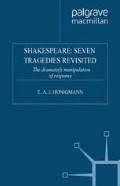Abstract
Although I have discussed only selected problems it will be clear by now that Shakespeare gave his unremitting attention to audience-response in each of his plays. The question ‘What should Hamlet do or say next?’ must have been inseparable for the dramatist from the question ‘How will it affect the audience?’ As he shaped each play its response problems seem to have been in the forefront of his mind, together with character and plot, at a more conscious level of decision-making than when he settled on its appropriate mood or imagery. While it would be wrong to suggest that its response problems are the only avenue of approach to a play (I have admitted this already), we cannot explain how it works without taking them into account at every turn.
Access this chapter
Tax calculation will be finalised at checkout
Purchases are for personal use only
Notes
In this chapter I have modernised the spelling of quotations. See also Gamini Salgado, Eyewitnesses of Shakespeare First Hand Accounts of Performances IS90–1890 (Sussex University Press, 1975), or, for the original spelling, E. K. Chambers, William Shakespeare (193o).
See L. Hotson, I, William Shakespeare (1937), especially chaps. VI and X.
H. S. Bennett, ‘Shakespeare’s Audience’ (in the Proceedings of the British Academy, XXX, 1944); cf. RES, 18 (i94z) 496–8.
See A. C. Sprague, Shakespeare and the Actors: The Stage Business in his Plays (1660–1905) (Cambridge, Mass., 1945); Shakespearian Players and Performances (5954); Shakespeare’s histories: plays for the stage (1964).
See also Shakespeare and the Sense of Performance Essays in the Tradition of Performance Criticism, eds Marvin and Ruth Thompson (Newark, Delaware, 1989).
H. R. Coursen, Shakespeare in Production: Whose History? (Athens, Ohio, 1996), P. 8.
John Barton, PlayingShakespeare (1984), p. 168.
See the Arden edition of Othello (1997)> P. 54, n•
See Jack J. Jorgens, Shakespeare on Film (Bloomington, Indiana, 1977) pp. 236–7.
See Reader-Response Criticism, ed. Jane P. Tompkins (Baltimore, 198o), or E. Freund. The Return of the Reader: Reader-Resbonse Criticism (5987).
Reprinted in W. K. Wimsatt’s The Verbal Icon (Lexington, Kentucky, 1954, 1967).
Copyright information
© 2002 E.A.J. Honigmann
About this chapter
Cite this chapter
Honigmann, E.A.J. (2002). Conclusion. In: Shakespeare: Seven Tragedies Revisited. Palgrave Macmillan, London. https://doi.org/10.1057/9780230503038_14
Download citation
DOI: https://doi.org/10.1057/9780230503038_14
Publisher Name: Palgrave Macmillan, London
Print ISBN: 978-0-333-99582-2
Online ISBN: 978-0-230-50303-8
eBook Packages: Palgrave Literature & Performing Arts CollectionLiterature, Cultural and Media Studies (R0)

